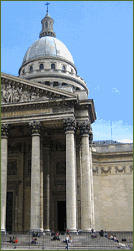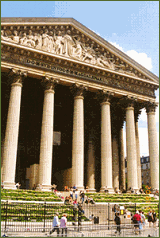|
Jacques-Germain Soufflot, the architect, had the intention of
combining the lightness and brightness of the gothic cathedral with classical principles,
but unfortunately, his plans were not entirely followed as Jacques-Germain Soufflot died
before his work was achieved, and the transparency he had planned for his masterpiece was
not attained.
Nevertheless, it is one of the most important architectural achievements of its time and
the first great neoclassical monument.
History
King Louis XV vowed in 1744 that if he recovered from an illness he would replace the
ruined church of Sainte-Genevieve with an edifice that would be worthy of the patron saint
of Paris.
The Marquis of Marigny was entrusted with the work and sponsored the architect
Jacques-Germain Soufflot, whom he chose for the construction of the new Eglise
Sainte-Genevieve, which is now known as the Pantheon.
The overall design was that of a Greek cross with a massive portico of Corinthian columns
and its ambitious lines called for a vast building 110 metres long by 84 metres wide, and
83 metres high.
The foundations were laid in 1758, but then due to financial difficulties, but it was only
completed after Soufflot's death by his pupil, Jean-Baptiste Rondelet, in 1789.
As it was completed at the start of the French Revolution, the new Revolutionary
government ordered it to be changed from a church to a mausoleum for the internment of
great Frenchmen. But since then it has reverted to being a church twice, only to
become again a temple to the great intellectuals of France.
In 1851 physicist Leon Foucault demonstrated the rotation of the Earth by his experiment
conducted in the Pantheon, by constructing a 67 metre Foucault pendulum beneath the
central dome. This original iron sphere from the pendulum was returned to the
Pantheon in 1995 from the Conservatoire National
des Arts et M?tiers.
Burial Place
The inscription above the entrance reads "To great men the grateful
homeland". The absence of a verb in French emphasises that the implicit notion
of honour is given from the great men to the homeland and by burying its great men in the
Pantheon, the Nation wants to acknowledge the honour it received from them. As such
its entrance is severely restricted and is allowed only by a parliamentary act for
"National Heroes".
Among those buried in its necropolis are Voltaire, Rousseau, Victor Hugo, Jean Moulin, Louis Braille and Jacques-Germain Soufflot,
its architect.
A story that said the remains of Voltaire were stolen by religious fanatics in 1814 and
thrown into a garbage heap, resulted in the coffin being opened in 1897, which confirmed
that his remains were still present.
On 30 November 2002, in an elaborate procession, six Republican Guards carried the coffin
of Alexandre Dumas, the author of The Three Musketeers, to the Pantheon. The remains
were transported from their original interment site in the Cimetiere de Villers-Cotterets
in Aisne, France, draped in a blue velvet cloth inscribed with the Musketeers' motto
"One for all, all for one". In the speech by President Jacques Chirac he
stated that an injustice was being corrected with the proper honouring of one of France's
greatest authors.
The Pantheon is open from the start of April to the end of September from 10am through to
6.30pm and then from October through to March it is open from 10am through to 6pm.
The last time you can enter is 45 minutes before closing time and please also note that it
is closed on all major holidays such as New Year.
The cost of entry for 2010 is €8 for an adult and €5 for concessions, however,
people under 18 are admitted free when accompanied by an adult.
Address & Contact Details:
Le Panth?on
Place du Pantheon
75005
Paris
France
Telephone: 1 44 32 18 00 or 1 44 32 18 01
Fax: 1 44 07 32 23
|
|



